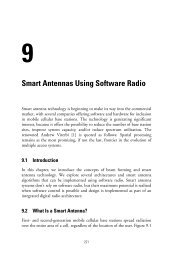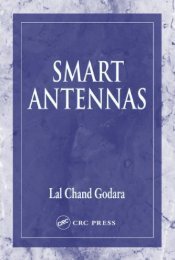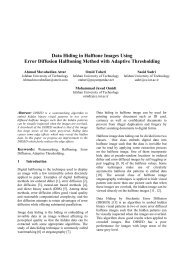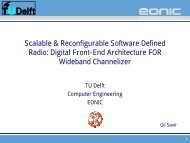ARM Architecture and Instruction Set - KTH
ARM Architecture and Instruction Set - KTH
ARM Architecture and Instruction Set - KTH
Create successful ePaper yourself
Turn your PDF publications into a flip-book with our unique Google optimized e-Paper software.
<strong>ARM</strong><strong>Architecture</strong> <strong>and</strong><strong>Instruction</strong> <strong>Set</strong>Ingo S<strong>and</strong>eringo@imit.kth.se<strong>ARM</strong> Microprocessor Core• <strong>ARM</strong> is a family of RISCarchitectures, whichshare the same designprinciples <strong>and</strong> acommon instruction set• <strong>ARM</strong> does notmanufacture the CPUitself, but licenses it toother manufacturers tointegrate them into theirown system• The <strong>ARM</strong> Core as partof a system-on-chip<strong>ARM</strong>CoreMemASICI/OUnitsDSPAugust 31, 2004 2B1447 Embedded Systems 2<strong>ARM</strong> Microprocessor Core• The <strong>ARM</strong> core is widely used in mobile phones, h<strong>and</strong>heldorganizers, <strong>and</strong> many other portable consumer devices• Depending on the application <strong>ARM</strong> processors are available withe.g.• Different Cache Sizes• Different Bus Widths• Varying Clock Speeds• Different Versions use different architectures, e.g.• <strong>ARM</strong> 7: von Neumann• <strong>ARM</strong> 9: Harvard• The assembly programs are not affected by the underlyingarchitecture<strong>ARM</strong> assembly language• The assembly language reflects the instruction set (almost one toone)• One instruction per line• Labels provide names for addresses (usually in first column)• <strong>Instruction</strong>s often start in later columns.• Columns run to end of line• Example:MOV r1, #100000Loop SUB r1, r1, #1 ; a wait loopBGE LoopCont …Label<strong>Instruction</strong>sCommentAugust 31, 2004 2B1447 Embedded Systems 3August 31, 2004 2B1447 Embedded Systems 4
SingleRegister-Memory Transfers• Data oper<strong>and</strong>s must be loaded into registers beforethey can be processed by an ALU• The Load <strong>and</strong> Store instructions can be combinedwith different addressing modes• The basic Load instruction is LDR (load word intoregister), but there are variations that work on byte(LDRB), halfword (LDRH) <strong>and</strong> signed bytes(LDRSB)• The basic Store instruction is STR (save word froma register), variations are STRB och STRHExample for LoadBefore:r0 = 0x00000000r1 = 0x00070000mem32[0x00070000] = 0x00000005LDR r0, [r1]After:r0 = 0x00000005r1 = 0x00070000August 31, 2004 2B1447 Embedded Systems 21August 31, 2004 2B1447 Embedded Systems 22Useful addressing modes:PreindexingBefore:r0 = 0x00000000r1 = 0x00007000mem32[0x00007000] = 0x00001000mem32[0x00007004] = 0x00002000Preindexing: LDR r0, [r1, #4]After:r0 = 0x00002000r1 = 0x00007000Useful addressing modes:Preindexing with WritebackBefore:r0 = 0x00000000r1 = 0x00007000mem32[0x00007000] = 0x00001000mem32[0x00007004] = 0x00002000Preindexing with Writeback: LDR r0, [r1, #4]!After:r0 = 0x00002000r1 = 0x00007004August 31, 2004 2B1447 Embedded Systems 23August 31, 2004 2B1447 Embedded Systems 24
Loading Constants• There are two pseudo-instructions to loadconstantsLDR r1, =0x7000 ; loads r1 with constant 0x7000ADR r2, label ; loads r2 with address for labelData Processing <strong>Instruction</strong>s• Data processing instructions manipulate datawithin registers (Move, Arithmetic, Logical,Comparison, Multiply)• If the S suffix is used the CPSR flags N, Z, C,V are updated• ADD r1, r2, r3 does not update CPSR• ADDS r1, r2, r3 updates the CPSRAugust 31, 2004 2B1447 Embedded Systems 29August 31, 2004 2B1447 Embedded Systems 30Data Processing <strong>Instruction</strong>s<strong>and</strong> CPSRMOVS r1, #1⇒ NZCV = 0000MOVS r2, #-1⇒ NZCV = 1000ADD r3, r2, r1⇒ NZCV = 1000ADDS r3, r2, r1⇒ NZCV = 0110Data Processing <strong>Instruction</strong>s• Move: MOV, MVN• Arithmetic: ADD, ADC, SUB, SBC, RSB,RSC• Logical: AND, ORR, EOR, BIC• Comparison: CMP, CMN, TST, TEQ• Multiply: MUL, MLA, SMLAL, SMULL,UMULL, SMLAL, UMLALAugust 31, 2004 2B1447 Embedded Systems 31August 31, 2004 2B1447 Embedded Systems 32
Formats for data processinginstructions• Basic formatSUB r3, r2, r1 ; r3 = r2 – r1• Immediate Oper<strong>and</strong>SUB r3, r2, #3 ; r3 = r2 - 3• Preprocessing (Barrel-Shifter)SUB r3, r2, r1, LSL #1 ; r3 = r2 – (r1 * 2)The Barrel Shifter• The barrel shifter allows aninitial shift operation before itenters the ALU• Shift Operations: LSL,LSR, ASR, ROR, RRX• Example:• MOV r3, r4, LSL #3;r3 = 8 * r4RnArithmeticLogicUnitRdRmBarrelShifterResult NAugust 31, 2004 2B1447 Embedded Systems 33August 31, 2004 2B1447 Embedded Systems 34Branch <strong>Instruction</strong>s• The branch instruction is used to change the flow ofexecution (if-then-else, for-loop, while-loop)• Branch <strong>Instruction</strong>s: B, BL, BX, BLX• Branches are often used with conditions (EQ, NE,CS, CC, MI, PL, VS, HI, LS, GE, LT,GT, LE)• BEQ label ; Branch to label, if Z = 1• The address label is stored in the instruction as aPC-relative offset <strong>and</strong> must be within 32MB of thebranch instructionSubroutines• The BL (Branch <strong>and</strong> Link) instruction can beused for subroutines, since it writes thereturnaddress to the link registerBL subroutine...subroutine... ; code for subroutineMOV pc, lr ; return by moving lr to pcAugust 31, 2004 2B1447 Embedded Systems 35August 31, 2004 2B1447 Embedded Systems 36
Conditional Execution• Not only branch instructions can be used withconditions• ADDEQ r4, r5, r6 is only executed if Z = 1• Conditional Execution helps to design shorterprograms that do not use so much memorySummary• <strong>ARM</strong> is a family of microprocessor cores• Load/store architecture• Most instructions are RISCy, operate insingle cycle• Some multi-register operations take longer• All instructions can be executed conditionallyAugust 31, 2004 2B1447 Embedded Systems 37August 31, 2004 2B1447 Embedded Systems 38


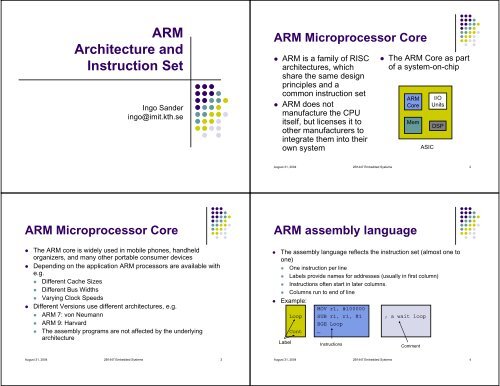
![[2]Cognitive radio architecture : the engineering ... - M. Javad Omidi](https://img.yumpu.com/50587986/1/163x260/2cognitive-radio-architecture-the-engineering-m-javad-omidi.jpg?quality=85)
